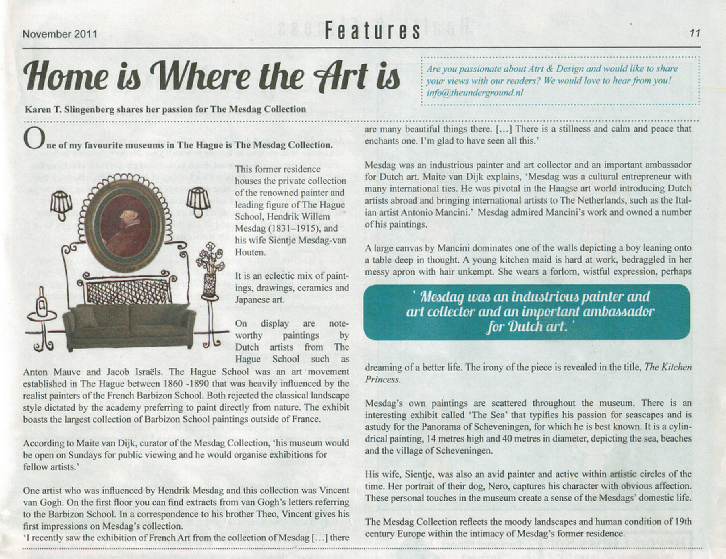

This article is one of my ‘lessons learned’. I wrote it for an expat monthly newspaper called ‘The Underground’ that was just coming out with it’s first edition. A really nice initiative.
The disappointment came when I saw my contribution in print. Without consultation the article had not only been cut but also changed. There were things there I had not written. I am used to working with editors and making changes as they desire. I love to hear opinions and improve my work so it meets their wishes. It only makes me a better writer. But an article under my name that is changed without any consultation, that was too much for me. As the editor could not promise me it would not happen again, I withdrew my future contributions for the Underground newspaper.
Be that as it may, I should have realized this was a new newspaper that might not have established editing rules. I learned that it is important to agree beforehand on how the editing process of the article is going to take place.
I still show the article here, together with the text that was supposed to be printed. I wonder which you like best.
Home is where the art is.
The Hague lays claim to a variety of museums worth visiting, some of which are housed within former residences, homes that once belonged to prominent Dutch characters from the past.
One of these museums is ‘The Mesdag Collection’, a highly esteemed assortment of
paintings, drawings, ceramics and Japanese art collected by the renowned painter
and leading figure of The Hague School, Hendrik Willem Mesdag (1831–1915), and his
wife Sientje Mesdag-
The exhibits are those that Mesdag collected from various contemporary artists and friends. There are some noteworthy paintings by Dutch artists from The Hague School such as Anton Mauve and Jacob Israëls. The Hague School is the name given to a group of artists who lived and worked in The Hague between 1860 and 1890. Their work was heavily influenced by the realist painters of the French Barbizon School. The Barbizon School of French landscape painting derived its named from Barbizon village in northern France, where most of the school’s painters resided. This group of men lead by Theodore Rousseau rejected the classical landscape style and insisted upon direct study from nature.The majority of the paintings are from the Barbizon School, the most significant collection of its kind outside France. Camille Corot and Théodore Rousseau grace the walls of Mesdag’s treasure trove which was built as an extension to his home to become his private museum. According to Maite van Dijk, Curator of the Mesdag Collection; ‘His museum would be open on Sundays for public viewing and he would organise exhibitions for fellow artists and other members of the general public to come and view the paintings’.
An artist who was influenced by Hendrik Mesdag and his collection was Vincent van Gogh. Upstairs there is a temporary exhibition of paintings and also extracts from van Gogh’s letters with his observations on the Barbizon School. In the correspondence to his brother Theo, Vincent gives his first impressions on Mesdag’s collection; ‘I recently saw the exhibition of French Art from the collection of Mesdag […] there are many beautiful things there. […] There is a stillness and calm and peace that enchants one. I’m glad to have seen all this’.
Mesdag was an industrious character, as besides being a painter and art collector, he was also an important ambassador for Dutch art. Maite van Dijk explains; ‘Mesdag was a cultural entrepreneur with many international ties. He was pivotal in the ‘Haagse’ art world and introduced Dutch artists abroad, but also introduced international artists into The Netherlands such as the Italian artist Mancini.’ Mesdag loved Mancini’s work and has a number of his paintings on display in the collection.
What sets this museum apart is the original 19th Century setting as well as the private
personal nature of the collection. On entering the space there is an intimacy that
many museums lack. The high ceilings, wooden floors and decorative wall-
Mesdag’s wife Sientje was also an avid painter and was active within artistic circles of the time. Not to be missed is Sientje’s portrait of their dog Nero in which she manages to capture his character with obvious affection. These kinds of personal touches in the museum create a sense of the Mesdag’s home life.
The Mesdag Collection is a museum that will appeal to those who are interested in the human condition, moody landscapes, sketchy painting styles and those who want to be spectators to lively scenes from 19th Century life within the surroundings of Mesdag’s historical stately home.